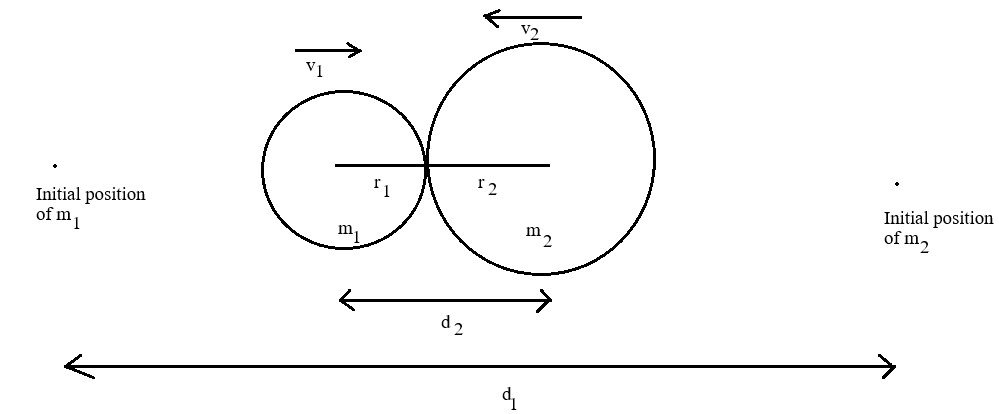Two insulating spheres have radil 0.300 cm and 0.500 cm, masses 0.200 kg and 0.700 kg, and uniformly distributed charges of -2.00 μC and 6.00 pc. They are released from rest when their centers are separated by 1.00 m. (a) How fast will each be moving when they collide? (Hint: Consider conservation of energy and of linear momentum.) m/s (lighter sphere) m/s (heavier sphere) (b) If the spheres were conductors, would the speeds be greater or less than those calculated in part (a)? (Note: Assume a reference level of potential V-0 at r=0.) O the same greater O less than
Two insulating spheres have radil 0.300 cm and 0.500 cm, masses 0.200 kg and 0.700 kg, and uniformly distributed charges of -2.00 μC and 6.00 pc. They are released from rest when their centers are separated by 1.00 m. (a) How fast will each be moving when they collide? (Hint: Consider conservation of energy and of linear momentum.) m/s (lighter sphere) m/s (heavier sphere) (b) If the spheres were conductors, would the speeds be greater or less than those calculated in part (a)? (Note: Assume a reference level of potential V-0 at r=0.) O the same greater O less than
College Physics
11th Edition
ISBN:9781305952300
Author:Raymond A. Serway, Chris Vuille
Publisher:Raymond A. Serway, Chris Vuille
Chapter1: Units, Trigonometry. And Vectors
Section: Chapter Questions
Problem 1CQ: Estimate the order of magnitude of the length, in meters, of each of the following; (a) a mouse, (b)...
Related questions
Question

Transcribed Image Text:ASK YOUR TEACHER
Two insulating spheres have radii 0.300 cm and 0.500 cm, masses 0.200 kg and 0.700 kg, and uniformly distributed charges of -2.00 μC and 6.00 pc. They are released from rest when their centers are separated by 1.00 m.
(a) How fast will each be moving when they collide? (Hint: Consider conservation of energy and of linear momentum.)
m/s (lighter sphere)
m/s (heavier sphere)
(b) If the spheres were conductors, would the speeds be greater or less than those calculated in part (a)? (Note: Assume a reference level of potential V = 0 at r=0.)
O the same
greater
O less than
Explain your answer.
To
7
1
Z
2
F2
W
S
X
X
3
20
F3
E
D
$
4
C
R
F
%
5
T
G
MacBook Air
6
C
Y
&
7
H
U
N
8
(
9
JK
M
MY NOTES
O
.
Expert Solution
Step 1: Determine the given data:
Collision diagram:

Step by step
Solved in 4 steps with 5 images

Knowledge Booster
Learn more about
Need a deep-dive on the concept behind this application? Look no further. Learn more about this topic, physics and related others by exploring similar questions and additional content below.Recommended textbooks for you

College Physics
Physics
ISBN:
9781305952300
Author:
Raymond A. Serway, Chris Vuille
Publisher:
Cengage Learning

University Physics (14th Edition)
Physics
ISBN:
9780133969290
Author:
Hugh D. Young, Roger A. Freedman
Publisher:
PEARSON

Introduction To Quantum Mechanics
Physics
ISBN:
9781107189638
Author:
Griffiths, David J., Schroeter, Darrell F.
Publisher:
Cambridge University Press

College Physics
Physics
ISBN:
9781305952300
Author:
Raymond A. Serway, Chris Vuille
Publisher:
Cengage Learning

University Physics (14th Edition)
Physics
ISBN:
9780133969290
Author:
Hugh D. Young, Roger A. Freedman
Publisher:
PEARSON

Introduction To Quantum Mechanics
Physics
ISBN:
9781107189638
Author:
Griffiths, David J., Schroeter, Darrell F.
Publisher:
Cambridge University Press

Physics for Scientists and Engineers
Physics
ISBN:
9781337553278
Author:
Raymond A. Serway, John W. Jewett
Publisher:
Cengage Learning

Lecture- Tutorials for Introductory Astronomy
Physics
ISBN:
9780321820464
Author:
Edward E. Prather, Tim P. Slater, Jeff P. Adams, Gina Brissenden
Publisher:
Addison-Wesley

College Physics: A Strategic Approach (4th Editio…
Physics
ISBN:
9780134609034
Author:
Randall D. Knight (Professor Emeritus), Brian Jones, Stuart Field
Publisher:
PEARSON